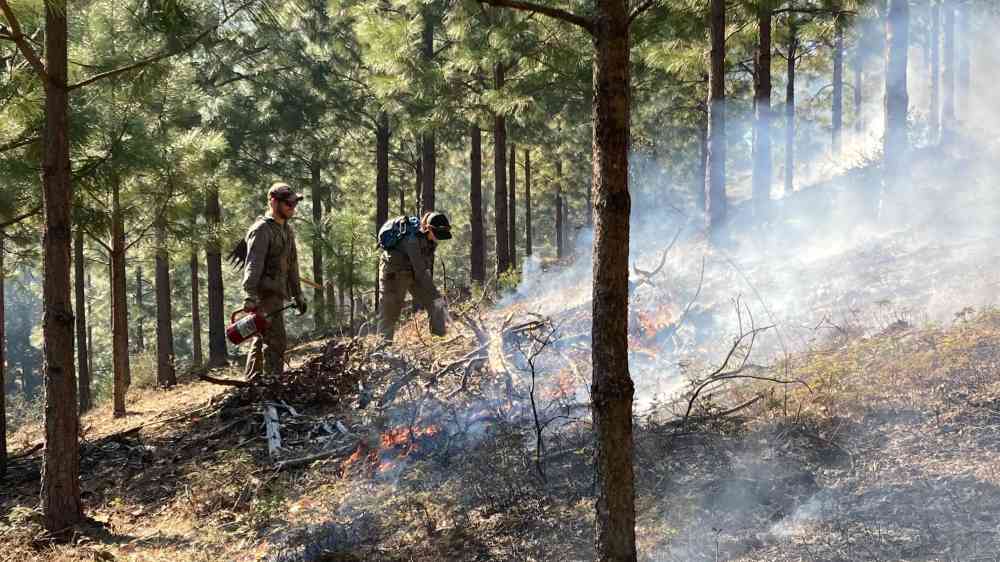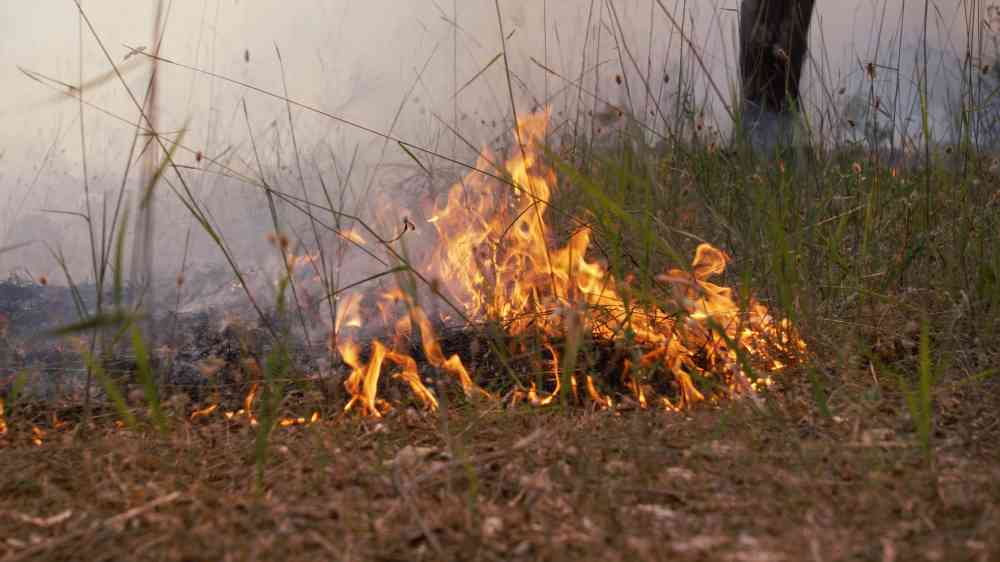Guiding the burn: How a Prescribed Fire Program Manager builds fire-resilient communities

Wildfires have become an increasingly serious disaster risk in California, US. Besides the risk of death, they cause widespread damage to private property, infrastructure, and the environment. In the 2024 wildfire season so far, the US State has seen nearly 6,800 wildfires burning more than one million acres (407,000 hectares).
California's wildfires have multiple causes, often linked to warmer temperatures, prolonged drought, and dense vegetation. Lightning strikes or human actions are often the primary cause. Combined with strong winds, the region has seen its wildfire seasons becoming longer and more intense.
Cordi Craig works in Placer Resource Conservation District (Placer RCD), an independent and self-governing special district, which occupies most of California's Placer County. Its mission is to promote the wise and sustainable stewardship of natural resources by inspiring responsible conservation practices.
Placer RCD provides technical assistance to anyone that wants it, and Cordi works as a Prescribed Fire Program Manager, helping to oversee the planning, implementation, and monitoring of prescribed fires, controlled fires which are used to manage vegetation, reduce the risk of uncontrolled wildfires, and maintain ecological balance.
PreventionWeb spoke with Cordi to learn how her role is helping communities in California build resilience to the ever-growing threat of wildfires.
Tell us a bit about your work and position
I am the Prescribed Fire Program Manager for Placer Resource Conservation District (Placer RCD). My job to support private landowners to implement safe, legal, and ecologically beneficial prescribed fires. These controlled fires help manage fuels, improve land stewardship, and improve wildfire resiliency. To do this, we manage the Placer Prescribed Burn Association (Placer PBA) and offer a combination of classroom workshops and hands-on training demonstrations. These ensure that landowners have the skills, knowledge, and confidence to use low-intensity, low-complexity prescribed fire.
I've been incredibly fortunate to have found my way onto the Placer RCD team! I served as an AmeriCorps member working for different environmental nonprofits in in Northern California, and eventually worked on a wildland firefighting crew. I loved firefighting and the opportunity to learn from experienced leaders who understood high-complexity fire behavior.
Today, I have the immense privilege of working with a mentor, who has 45 years of operational firefighting experience, to develop the prescribed fire program at Placer RCD. I also attribute the program's success to strong support from the Placer PBA Advisory Committee, which includes local representatives from CAL FIRE, Todd's Valley Miwok Maidu Cultural Foundation, the Colfax-Todd's Valley Consolidated Tribe, Placer Air Pollution Control District, the Natural Resources Conservation Service, the UC Cooperative Extension, and the US Forest Service. Their contributions and perspectives have made the program even stronger and more effective than we could have ever imagined.

Has California's exposure to wildfires changed over recent years?
Ignition sources have always been present in California and always will be. These ignitions could be anthropogenic ignitions, such as downed powerlines, or they could be natural like lightning. We live in a fire-dependent ecosystem, where our native plants and animals have adapted to and evolved with low- and moderate-intensity fire.
However, in the last 200 years, two major factors have dramatically changed our forests: the California genocide, which led to the displacement of indigenous Tribes who actively managed the land with fire, and the introduction of fire suppression policies. These events have significantly changed the structure and function of our forests. We have reached a tipping point in history.
The lack of regular, low-intensity fires has led to an overwhelming build-up of fuel that cannot be suppressed with technology. In fact, the five largest and most devastating wildfires in the state's history have all occurred in the last five years. This high fuel load, combined with periods of prolonged drought and the escalating effects of climate change, means that wildfire seasons are lasting longer, and the wet seasons are becoming drier and warmer.
This reality calls for community members and landowners to become advocates for prescribed burning and active land management. We live in a fire-dependent ecosystem and the future of our communities therefore depends on the return of low-intensity fire to our landscape.
How does your work help in making communities more fire resilient?
Our work focuses on expanding access to - and knowledge of - prescribed fire for community members in the Sierra Nevada foothills. The complexity of applying prescribed fire varies greatly based on a variety of factors such as topography, size, fuel type, seasonality, assets at risk, management objectives, and unit preparation work. Placer PBA teaches private landowners how to reduce this complexity as much as possible, enabling them to apply fire to low-complexity units. This allows fire suppression agencies, such as CAL FIRE and the US Forest Service, to concentrate their skills, experience, and effort on larger, more complex prescribed burns.

State and federal governmental agencies simply do not have the capacity, flexibility, or staffing to assist every private landowner. As a state, we cannot achieve the governor's ambitious goal to treat 1 million acres without contributions from private landowners.
In addition to the technical skills of prescribed burning, active and open communication and relationship building are critical to fire-resilient communities.
We are excited to report success: Between October 2022 and July 2023, Placer PBA hosted 7 workshops and 18 training burns. Although the training burns collectively covered just 25 acres, they successfully equipped community members with the knowledge, skills, and confidence to do their own burns independently. We distributed a questionnaire to participating landowners to track their post-training efforts, and the results were impressive. A total of 47 landowners implemented more than 260 acres of broadcast burning, with most having very little or no previous fire experience before the training. The average burn unit size was 5.9 acres and there were no reports of escapes, injuries, or financial damages.
Check out our web map to see all the locations of landowner burns throughout the Sierra Nevada. The program's success clearly demonstrates that education and accessibility are key to achieving landscape-scale implementation.
Placer RCD's mission goes beyond teaching the skills to safely apply prescribed fire. It also focuses on increasing the community's understanding of fire as a critical land management tool. In a fire-dependent ecosystem, during particular times of the year, seeing smoke should not trigger anxiety. Instead, it should be recognized as a natural and positive sign of active land management.
In addition to directly treating fuel loads, we aim to create more visibility for prescribed fires through community exposure, smokestacks, and positive media coverage. This will help to build a fire-resilient and fire-adapted community. We must learn to live with fire.
Can you share some examples of communities that have adapted well to wildfire risk? Have they had measurable results?
In many of the large wildfires that have swept across the state, there are examples of prescribed burns that moderated fire behavior and prevented more significant damage. Although it's difficult to say explicitly that these prescribed burn treatments were the only factor that affected wildfire impacts, they certainly appeared to play a pivotal role for fire suppression efforts. The most recent example was during the 2024 Park Fire, where a previous prescribed burn, conducted with support from the Butte Prescribed Burn Association/TREX, may have helped save homes in the town of Cohasset. There are additional examples from the Caldor and Dixie Fires. These are great examples of the type of work that organizations, agencies, and private landowners are working towards scaling up across the state and, if implemented, will help our communities become more well-adapted to wildfires.

Apart from tools and technical methods to make communities more resilient, are there, in your opinion, other qualities or skills that community members should develop in a context of increasing risks?
Yes, in addition to the technical skills of prescribed burning, active and open communication and relationship building are critical to fire-resilient communities. In my experience, the landowners who have been the most successful are the ones who actively engage with their neighbours and develop strong, trusting relationships with the prescribed fire permitting agencies, such as CAL FIRE and the local air district.
The lack of regular, low-intensity fires has led to an overwhelming build-up of fuel that cannot be suppressed with technology
While prescribed fire helps to restore natural ecosystems, we operate within a society run by people. Establishing transparent, open, and trusting relationships is the key to success.
What advice would you give young people wishing to work in the field of disaster resilience?
It's not the most polite advice but "shut up and listen" was probably the most valuable guidance that was given to me in this position. Creating space to hear about the needs of the community, along with input from stakeholders and partners, is essential. It forces us to stop assuming that we know what our community wants or needs.
I've started projects that ended up failing because they did not align with the actual needs of the community and therefore did not gain momentum. However, there are still valuable lessons to be learned from failure. Now, when I plan events, I try to create environments where community members feel welcome and comfortable sharing their ideas about how the RCD and prescribed burn programs can better serve them and their communities.
This approach has allowed people to give honest feedback, also fostering transparency and trust between our organization and the community. We can't always say "yes" to every suggestion or implement changes immediately, but it has allowed Placer RCD to create a dialogue with community members and allow us - when grant opportunities are available - to respond with solutions.

Cordi Craig is the Prescribed Fire Program Manager at Placer Resource Conservation District (Placer RCD). She manages the Placer Prescribed Burn Association and trains private landowners how to successfully prep, plan, and implement low-complexity prescribed burns. Before working at Placer RCD, she was a wildland firefighter with the Humboldt-Toiyabe National Forest and spent her off-seasons working for residential tree companies and freelance writing. She became a state-certified burn boss (CARX) in October 2022 and continues to learn from leaders, volunteers, and community members, both on and off the fireground. She enjoys whitewater rafting, backpacking, and therapeutic pile burning with her blue nose Pitbull, Miss Piggy
